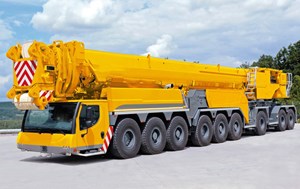Off-Highway Research offers data and analysis on international markets for mobile cranes through its Chinese and Indian Database Services, Equipment Analyses from the European, Indian and Chinese Services, Country Analyses from the European Service and Special Reports on emerging markets, as well as our Special Report on the Global Mobile Crane Industry. Coverage includes all terrain, industrial, lattice-boom crawler, pick & carry, truck-mounted and rough terrain cranes.
 Mobile cranes
Mobile cranesOff-Highway Research covers the following types of mobile cranes:
All terrain cranes are designed to have the road-going mobility of a truck mounted crane as well as the ability to operate in rough terrain conditions. Featuring a truck chassis, they have similarities to truck-mounted cranes, but are differentiated by large tyres to provide ground clearance and off-road mobility, a multi-axle chassis and all-wheel drive and steering.
These machines are mounted on crawler chassis and are generally fitted with lattice booms on a slewing upper structure.
These machines are often referred to as self-propelled or yard cranes, and can be fitted with either telescopic or lattice booms. They are small, general purpose material handling cranes with a low travel speed, designed for use in firm ground conditions.
Pick & carry cranes are unique to India and surrounding countries. They feature a non-slewing design with a rear-mounted, forward-facing boom. The chassis usually comprises a rear two-wheeled tractor unit, connected via an articulation joint to non-driven, front axle which also supports the boom. They are therefore two-wheel drive machines, which are steered by means of pivoting about the articulation point. Lifting capacities are typically 25 tonnes or less.
Although now purpose-built as pick & carry cranes, the original models made use of a disused tractor or backhoe loader for the rear drive unit.
Rough terrain cranes invariably have two axles and feature high ground clearance and high floatation tyres for off-road manoeuvrability, which is also aided by all-wheel driving and steering. It is not usually permissible to drive rough terrain cranes on public highways, although there are exceptions in certain countries.
These machines predominantly have telescopic booms, although they are also available with lattice booms. They are designed to travel on public highways and are often based on, or mounted on commercially available truck chassis. They are powered by a diesel engine and employ hydraulic systems to drive the boom and lifting gear.
Having reached an extraordinary peak of almost 55,000 mobile cranes sold in China in 2020, demand for these machines is continuing to cool as the economy slows.
Demand for mobile cranes in the UK is recovering following the downturn of 2020, but with uncertainty over infrastructure projects, the market is expected to take two more years to return to its former health.
Niamh Marriot, deputy editor of International Cranes and Specialized Transport interviews Chris Sleight, Managing Director of Off-Highway Research on some of the findings from the new study on the world's largest crane fleets.
A new study carried out in partnership between Off-Highway Research and International Cranes and Specialized Transport (ICST) magazine sheds new light on the development, size and composition of the world’s largest mobile crane fleets.
Record mobile crane sales and production will be seen in China this year for the second year running.
|
KHL Media Limited © Off-Highway Research 2025 All right reserved |
About Us Privacy Policy |
Contact Us Terms & Conditions |